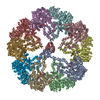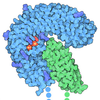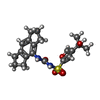[English] 日本語
 Yorodumi
Yorodumi- PDB-7pzc: Cryo-EM structure of the NLRP3 decamer bound to the inhibitor CRID3 -
+ Open data
Open data
- Basic information
Basic information
| Entry | Database: PDB / ID: 7pzc | ||||||
|---|---|---|---|---|---|---|---|
| Title | Cryo-EM structure of the NLRP3 decamer bound to the inhibitor CRID3 | ||||||
 Components Components | NACHT, LRR and PYD domains-containing protein 3 | ||||||
 Keywords Keywords | IMMUNE SYSTEM / NLRP3 / CP-456.773 / CRID3 / MCC950 / AAA+ ATPase / NOD-like receptor / inflammasome | ||||||
| Function / homology |  Function and homology information Function and homology informationdetection of biotic stimulus / molecular sensor activity / phosphatidylinositol phosphate binding / positive regulation of T-helper 2 cell differentiation / NLRP3 inflammasome complex assembly / positive regulation of T-helper 2 cell cytokine production / interphase microtubule organizing center / positive regulation of type 2 immune response / NLRP3 inflammasome complex / cysteine-type endopeptidase activator activity ...detection of biotic stimulus / molecular sensor activity / phosphatidylinositol phosphate binding / positive regulation of T-helper 2 cell differentiation / NLRP3 inflammasome complex assembly / positive regulation of T-helper 2 cell cytokine production / interphase microtubule organizing center / positive regulation of type 2 immune response / NLRP3 inflammasome complex / cysteine-type endopeptidase activator activity / peptidoglycan binding / osmosensory signaling pathway / phosphatidylinositol-4-phosphate binding / negative regulation of non-canonical NF-kappaB signal transduction / pattern recognition receptor signaling pathway / negative regulation of interleukin-1 beta production / pyroptotic inflammatory response / positive regulation of interleukin-4 production / microtubule organizing center / negative regulation of acute inflammatory response / The NLRP3 inflammasome / Purinergic signaling in leishmaniasis infection / signaling adaptor activity / protein maturation / positive regulation of interleukin-1 beta production / molecular condensate scaffold activity / defense response / positive regulation of non-canonical NF-kappaB signal transduction / Cytoprotection by HMOX1 / ADP binding / protein homooligomerization / cellular response to virus / Hydrolases; Acting on acid anhydrides; Acting on acid anhydrides to facilitate cellular and subcellular movement / negative regulation of inflammatory response / Metalloprotease DUBs / positive regulation of inflammatory response / positive regulation of NF-kappaB transcription factor activity / SARS-CoV-1 activates/modulates innate immune responses / cellular response to lipopolysaccharide / regulation of inflammatory response / protein-macromolecule adaptor activity / DNA-binding transcription factor binding / molecular adaptor activity / sequence-specific DNA binding / inflammatory response / Golgi membrane / innate immune response / apoptotic process / SARS-CoV-2 activates/modulates innate and adaptive immune responses / endoplasmic reticulum / signal transduction / positive regulation of transcription by RNA polymerase II / ATP hydrolysis activity / mitochondrion / extracellular region / ATP binding / identical protein binding / nucleus / membrane / cytosol / cytoplasm Similarity search - Function | ||||||
| Biological species |  Homo sapiens (human) Homo sapiens (human) | ||||||
| Method | ELECTRON MICROSCOPY / single particle reconstruction / cryo EM / Resolution: 3.9 Å | ||||||
 Authors Authors | Hochheiser, I.V. / Pilsl, M. / Hagelueken, G. / Engel, C. / Geyer, M. | ||||||
| Funding support |  Germany, 1items Germany, 1items
| ||||||
 Citation Citation |  Journal: Nature / Year: 2022 Journal: Nature / Year: 2022Title: Structure of the NLRP3 decamer bound to the cytokine release inhibitor CRID3. Authors: Inga V Hochheiser / Michael Pilsl / Gregor Hagelueken / Jonas Moecking / Michael Marleaux / Rebecca Brinkschulte / Eicke Latz / Christoph Engel / Matthias Geyer /  Abstract: NLRP3 is an intracellular sensor protein that when activated by a broad spectrum of exogenous and endogenous stimuli leads to inflammasome formation and pyroptosis. The conformational states of NLRP3 ...NLRP3 is an intracellular sensor protein that when activated by a broad spectrum of exogenous and endogenous stimuli leads to inflammasome formation and pyroptosis. The conformational states of NLRP3 and the way antagonistic small molecules act at the molecular level remain poorly understood. Here we report the cryo-electron microscopy structures of full-length human NLRP3 in its native form and complexed with the inhibitor CRID3 (also named MCC950). Inactive, ADP-bound NLRP3 is a decamer composed of homodimers of intertwined leucine-rich repeat (LRR) domains that assemble back-to-back as pentamers. The NACHT domain is located at the apical axis of this spherical structure. One pyrin domain dimer is in addition formed inside the LRR cage. Molecular contacts between the concave sites of two opposing LRR domains are mediated by an acidic loop that extends from an LRR transition segment. Binding of CRID3 considerably stabilizes the NACHT and LRR domains relative to each other. CRID3 binds into a cleft, connecting four subdomains of the NACHT with the transition LRR. Its central sulfonylurea group interacts with the Walker A motif of the NLRP3 nucleotide-binding domain and is sandwiched between two arginine residues, which explains the specificity of NLRP3 for this chemical entity. With the determination of the binding site of this key therapeutic agent, specific targeting of NLRP3 for the treatment of autoinflammatory and autoimmune diseases and rational drug optimization is within reach. | ||||||
| History |
|
- Structure visualization
Structure visualization
| Movie |
 Movie viewer Movie viewer |
|---|---|
| Structure viewer | Molecule:  Molmil Molmil Jmol/JSmol Jmol/JSmol |
- Downloads & links
Downloads & links
- Download
Download
| PDBx/mmCIF format |  7pzc.cif.gz 7pzc.cif.gz | 1.5 MB | Display |  PDBx/mmCIF format PDBx/mmCIF format |
|---|---|---|---|---|
| PDB format |  pdb7pzc.ent.gz pdb7pzc.ent.gz | 1.3 MB | Display |  PDB format PDB format |
| PDBx/mmJSON format |  7pzc.json.gz 7pzc.json.gz | Tree view |  PDBx/mmJSON format PDBx/mmJSON format | |
| Others |  Other downloads Other downloads |
-Validation report
| Summary document |  7pzc_validation.pdf.gz 7pzc_validation.pdf.gz | 2.1 MB | Display |  wwPDB validaton report wwPDB validaton report |
|---|---|---|---|---|
| Full document |  7pzc_full_validation.pdf.gz 7pzc_full_validation.pdf.gz | 2.4 MB | Display | |
| Data in XML |  7pzc_validation.xml.gz 7pzc_validation.xml.gz | 235.8 KB | Display | |
| Data in CIF |  7pzc_validation.cif.gz 7pzc_validation.cif.gz | 326.5 KB | Display | |
| Arichive directory |  https://data.pdbj.org/pub/pdb/validation_reports/pz/7pzc https://data.pdbj.org/pub/pdb/validation_reports/pz/7pzc ftp://data.pdbj.org/pub/pdb/validation_reports/pz/7pzc ftp://data.pdbj.org/pub/pdb/validation_reports/pz/7pzc | HTTPS FTP |
-Related structure data
| Related structure data |  13686MC M: map data used to model this data C: citing same article ( |
|---|---|
| Similar structure data |
- Links
Links
- Assembly
Assembly
| Deposited unit | 
|
|---|---|
| 1 |
|
- Components
Components
| #1: Protein | Mass: 118323.531 Da / Num. of mol.: 10 Source method: isolated from a genetically manipulated source Source: (gene. exp.)  Homo sapiens (human) / Gene: NLRP3, C1orf7, CIAS1, NALP3, PYPAF1 / Production host: Homo sapiens (human) / Gene: NLRP3, C1orf7, CIAS1, NALP3, PYPAF1 / Production host:  #2: Chemical | ChemComp-ADP / #3: Chemical | ChemComp-8GI / Has ligand of interest | Y | |
|---|
-Experimental details
-Experiment
| Experiment | Method: ELECTRON MICROSCOPY |
|---|---|
| EM experiment | Aggregation state: PARTICLE / 3D reconstruction method: single particle reconstruction |
- Sample preparation
Sample preparation
| Component | Name: Decameric complex of the NLRP3 protein bound to ADP and CRID3 Type: COMPLEX / Entity ID: #1 / Source: RECOMBINANT |
|---|---|
| Molecular weight | Value: 1.18 MDa / Experimental value: YES |
| Source (natural) | Organism:  Homo sapiens (human) Homo sapiens (human) |
| Source (recombinant) | Organism:  |
| Buffer solution | pH: 7.5 Details: 50 mM Hepes pH 7.5, 150 mM NaCl, 0.5 mM TCEP, 10 mM MgCl2, 1 mM ADP |
| Specimen | Conc.: 0.01 mg/ml / Embedding applied: NO / Shadowing applied: NO / Staining applied: NO / Vitrification applied: YES |
| Vitrification | Instrument: FEI VITROBOT MARK IV / Cryogen name: ETHANE / Humidity: 100 % / Chamber temperature: 277 K |
- Electron microscopy imaging
Electron microscopy imaging
| Experimental equipment |  Model: Titan Krios / Image courtesy: FEI Company |
|---|---|
| Microscopy | Model: FEI TITAN KRIOS |
| Electron gun | Electron source:  FIELD EMISSION GUN / Accelerating voltage: 300 kV / Illumination mode: FLOOD BEAM FIELD EMISSION GUN / Accelerating voltage: 300 kV / Illumination mode: FLOOD BEAM |
| Electron lens | Mode: BRIGHT FIELD / Nominal defocus max: 1500 nm / Nominal defocus min: 750 nm |
| Specimen holder | Cryogen: NITROGEN / Specimen holder model: FEI TITAN KRIOS AUTOGRID HOLDER |
| Image recording | Electron dose: 45 e/Å2 / Film or detector model: GATAN K3 BIOQUANTUM (6k x 4k) |
- Processing
Processing
| EM software |
| ||||||||||||||||
|---|---|---|---|---|---|---|---|---|---|---|---|---|---|---|---|---|---|
| CTF correction | Type: PHASE FLIPPING AND AMPLITUDE CORRECTION | ||||||||||||||||
| Particle selection | Num. of particles selected: 1588061 | ||||||||||||||||
| Symmetry | Point symmetry: D5 (2x5 fold dihedral) | ||||||||||||||||
| 3D reconstruction | Resolution: 3.9 Å / Resolution method: FSC 0.143 CUT-OFF / Num. of particles: 161351 / Symmetry type: POINT | ||||||||||||||||
| Atomic model building | Protocol: AB INITIO MODEL |
 Movie
Movie Controller
Controller













 PDBj
PDBj

















